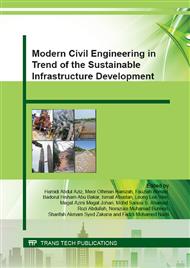[1]
B.V. Kok, M. Yilmaz, The effects of using lime and styrene-butadiene-styrene on moisture sensitivity resistance of hot mix asphalt, Constr. Build. Mater., 23(5) (2009)1999–(2006).
DOI: 10.1016/j.conbuildmat.2008.08.019
Google Scholar
[2]
R. L. Terrel, S. Al-Swailmi, Water Sensitivity of Asphalt-Aggregate Mixes : Test Selection. SHRP-A-403, Strateg. Highw. Res. program. Washingt. Natl. Res. Counc., (1994) 194.
Google Scholar
[3]
B. Sengoz and G. Isikyakar, Evaluation of the properties and microstructure of SBS and EVA polymer modified bitumen, Constr. Build. Mater., 22(2008)1897–(1905).
DOI: 10.1016/j.conbuildmat.2007.07.013
Google Scholar
[4]
E.A. Oluwasola, M.R. Hainin, and M.M.A. Aziz, Evaluation of asphalt mixtures incorporating electric arc furnace steel slag and copper mine tailings for road construction, Transp. Geotech., 2 (2015) 47-55.
DOI: 10.1016/j.trgeo.2014.09.004
Google Scholar
[5]
M. Yusri, B. Aman, and M.O. Hamzah, Effects of Anti-Stripping Additives on Moisture Sensitivity of Warm Porous Asphalt Mixtures, Int. J. Constr. Technol. Manag., 1 (2014) 1-7.
Google Scholar
[6]
G. D. Airey, Rheological evaluation of ethylene vinyl acetate polymer modified bitumens, Constr. Build. Mater. 16(8) (2002) 473-487.
DOI: 10.1016/s0950-0618(02)00103-4
Google Scholar
[7]
G. Rusbintardjo, M. R. Hainin, and N. I. M. Yusoff, Fundamental and rheological properties of oil palm fruit ash modified bitumen, Constr. Build. Mater., 49 (2013) 702–711.
DOI: 10.1016/j.conbuildmat.2013.08.056
Google Scholar
[8]
E. Shaffie, J. Ahmad, and D. Kamarun, Rutting Performance of Hot Mix Asphalt Mixture using Nanopolyacrylate Polymer Modifier, Adv. Eng. Technol., 752–753, (2015).
DOI: 10.4028/www.scientific.net/amm.752-753.194
Google Scholar
[9]
M. E. Abdullah, K. A. Zamhari, R. Buhari, M. N. Nayan, and M. R. Hainin, Short Term and Long Term Aging Effects of Asphalt Binder Modified with Montmorillonite, Key Eng. Mater., 594–595 (2013) 996–1002.
DOI: 10.4028/www.scientific.net/kem.594-595.996
Google Scholar
[10]
G. Liu, S. Wu, M. Van De Ven, A. Molenaar, and J. Besamusca, Characterization of Organic Surfactant on Montmorillonite Nanoclay to Be Used in Bitumen,J. Mater. Civ. Eng., 22, (2010) 794–799.
DOI: 10.1061/(asce)mt.1943-5533.0000013
Google Scholar
[11]
J. Yang and S. Tighe, A Review of Advances of Nanotechnology in Asphalt Mixtures, Procedia - Soc. Behav. Sci., 96 (2013) 1269–1276.
DOI: 10.1016/j.sbspro.2013.08.144
Google Scholar
[12]
A. Al-hadidy, Minimizing the Moisture Damage and Drain down of Iraqi SMA Mixtures Using Waste Additives, 18( 3) (2011).
DOI: 10.25130/tjes.18.3.08
Google Scholar
[13]
E. Shaffie, J. Ahmad, A. K. Arshad, D. Kamarun, F. Kamaruddin, and M. A. Shafiee, Physical Properties of Modified Asphalt Binder with Nanopolyacrylate ( NPA ), in International Civil and Infrastructure Engineeering (InCIEC 2013) (2013).
DOI: 10.1007/978-981-4585-02-6_34
Google Scholar
[14]
Public Work Department of Malaysia, Standard specificationfor road work, section 4: Flexible pavement. Kuala Lumpur, JKR/SPJ/2008-S4. (2008).
Google Scholar
[15]
American Association of State Highway and Transportation Officials (AASHTO), Resistance of compacted Hot Mix Asphalt (HMA) to Mixture-Induced Damage. AASHTO T283-07. (2008).
DOI: 10.17226/22918
Google Scholar
[16]
E. Santagata, O. Baglieri, L. Tsantilis, and D. Dalmazzo, Rheological Characterization of Bituminous Binders Modified with Carbon Nanotubes, Procedia - Soc. Behav. Sci., 53 (2012) 546–555.
DOI: 10.1016/j.sbspro.2012.09.905
Google Scholar
[17]
M. Jr. Cooley L.A. Prowell, B.D. Hainin, Comparison of the Saturated Surface-Dry and Vacuum Sealing Methods for Determining the Bulk Specific Gravity of Compacted HMA,J. Assoc. Asph. Paving Technol., 72 no. ISSN: 0270–2932 (2003) p.2932.
Google Scholar
[18]
J. Ahmad, N. I. M. Yusoff, M. R. Hainin, M. Y. A. Rahman, and M. Hossain, Investigation into hot-mix asphalt moisture-induced damage under tropical climatic conditions, Constr. Build. Mater., 50 (2014) p.567–576.
DOI: 10.1016/j.conbuildmat.2013.10.017
Google Scholar


